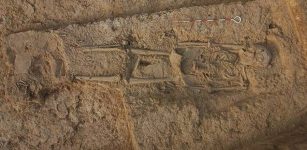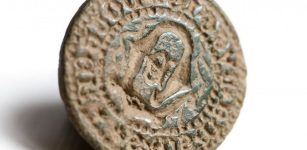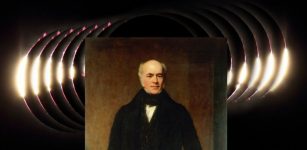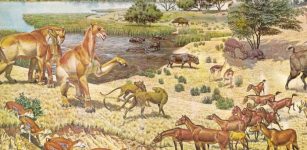Vercingetorix: Greatest Of All Gallic Leaders And Hero Of The French People
A. Sutherland - AncientPages.com - Vercingetorix was among the best-known and greatest Gallic leaders. He was a militant leader who courageously challenged Julius Caesar. He lost his battle but retained the honor by giving his own freedom and life in exchange for saving his people.
He was strangled on Sep 26, 46 BC.
Who was Vercingetorix?
Statue of Vercingetorix, Alesia. Credit: Carole Raddato - CC BY-SA 2.0
He belonged to the Arverni people, one of the most powerful Celtic tribes in ancient Gaul. The Arverni had their massive stronghold Gergovia in south-central France.
The Arverni made Vercingetorix their king, and even the chieftains of a confederation of Gallic tribes supported him as commander-in-chief. He was a charismatic and respected leader, but he was not the commander of a unified force.
Vercingetorix was a young nobleman whose father was killed while attempting to become king. He could not rely on his family; his uncle and the rest of the nobles believed that opposing Julius Caesar was a too great risk.
In his fight against the common enemy, Rome, Vercingetorix had become a seasoned warrior; he gathered an army of poor men, made alliances with other tribes, and took the mountain stronghold of Gergovia (52 BC) in a battle in which several thousands of Romans and allies died, and Caesar's Roman legions withdrew.
For now, Vercingetorix was welcomed there as the king.
Troublesome Gaul (modern France and Belgium)
The conquest of Gaul (France) lasted about a decade: the Romans entered the Alps in 58 BC.
Vercingetorix throws down his arms at the feet of Julius Caesar. Siege of Alesia painting by Lionel Royer (1852–1926). Credit: Public Domain
The Gauls did not form a single state but consisted of many states of different ethnic origins.
In the late Iron Age, their different cultures (called Celts or Gauls by the Greeks and Romans) had started to resemble each other, largely due to trade and exchange. They were also feared by neighbors because of their systematic invasions.
While Caesar conquered one tribe, the other was about to rebel, and among the Gauls, he had the greatest enemy -Vercingetorix, who learned the tactics and strategy of the Romans.
Perhaps he secretly dreamed of achieving something similar to what his father, unfortunately, could not.
He was disappointed; he wanted to help his people who faced brutal treatment from Caesar’s soldiers running around in Gaul, attacking tribe after tribe after tribe for more than five years. It is believed that about a million people perished during these activities.
Small victories only and finally fatal strategic error
Vercingetorix knew about the difficult political situation of Caesar: triumvirate was falling apart - Crassus was killed in the sands of the Middle East against the Parthians, and Pompey was more and more influential in Italy.
It was the best time to start the uprising. Vercingetorix gathered a large, highly mobile army. In fact, in the beginning, he pressed the attack repeatedly and achieved small victories, forcing Caesar's army to withdraw to the south.
Statue of Vercingetorix by Frédéric Bartholdi, on Place de Jaude, in Clermont-Ferrand, France. Image via wikipedia
Vercingetorix’s strategy appeared to be working, but then the turning point was the Battle of the Saône. At that point, Vercingetorix was forced to retreat because he had difficulties feeding his men. He decided to head north to his main supply base at Alesia (modern-day Alise-Sainte-Reine in eastern France) to regroup, refit, and resupply.
Suddenly, he learned that Caesar decided to pursue him instead of returning to Rome. Vercingetorix’s decision to retreat to Alesia - whatever the reason for it he had – it would prove to be a fatal strategic error. Instead of confrontation in a battle, Caesar began the Siege of Alesia.
Finally, food stores were almost running out inside Alesia, and real suffering began. The Gauls began to pursue acts of cannibalism and fell all hope of victory. Apparently, Vercingetorix's attempt to unite the Gauls against Roman tyranny and win the battle came too late.
Christopher Lambert as Vercingetorix in the movie Druids. Credit: IMDb
Vercingetorix decided to surrender to Caesar immediately and pay tribute to Caesar by offering himself for sparing his people. His captors did not treat him in the way his bravery deserved. He was taken into prison in Roma for six years. In 46 BC, Vercingetorix—a proud and very courageous warrior—was executed (probably strangled). Unfortunately, he died not like a warrior in a battle.
Many monuments of Vercingetorix were erected in France during the 19th century; he is alive in the memory of the French people.
Written by – A. Sutherland AncientPages.com Staff Writer
Updated on April 4, 2024
Copyright © AncientPages.com All rights reserved. This material may not be published, broadcast, rewritten or redistributed in whole or part without the express written permission of AncientPages.com
Expand for referencesMore From Ancient Pages
-
 A 4,500-Year-Old Collective Tomb In France Reveals Its Secret – The Final Stage In The Formation Of The ‘European Genome’
Featured Stories | Jul 5, 2024
A 4,500-Year-Old Collective Tomb In France Reveals Its Secret – The Final Stage In The Formation Of The ‘European Genome’
Featured Stories | Jul 5, 2024 -
 Ancient City Of Koh Ker Was Occupied Much Longer Than Previously Thought
Archaeology | Oct 12, 2018
Ancient City Of Koh Ker Was Occupied Much Longer Than Previously Thought
Archaeology | Oct 12, 2018 -
 Jars With 2,600-Year-Old Vanilla Remnants Discovered In The City Of David
Archaeology | Mar 31, 2022
Jars With 2,600-Year-Old Vanilla Remnants Discovered In The City Of David
Archaeology | Mar 31, 2022 -
 Surprising New Insights Into Use And Increased Production Of Pottery At The End Of The Last Ice Age
Archaeology | Mar 22, 2016
Surprising New Insights Into Use And Increased Production Of Pottery At The End Of The Last Ice Age
Archaeology | Mar 22, 2016 -
 Early Harappan Burial Site With 26 Graves Unearthed In Kutch, Western India
Archaeology | Mar 14, 2019
Early Harappan Burial Site With 26 Graves Unearthed In Kutch, Western India
Archaeology | Mar 14, 2019 -
 A Glimpse Into The Past – Sights And Sounds Of St. Paul’s Cathedral Recreated
Archaeology | Oct 8, 2021
A Glimpse Into The Past – Sights And Sounds Of St. Paul’s Cathedral Recreated
Archaeology | Oct 8, 2021 -
 5 Different Types Of Priests In Ancient Rome – Their Role And Responsibility Explained
Ancient History Facts | Jan 30, 2018
5 Different Types Of Priests In Ancient Rome – Their Role And Responsibility Explained
Ancient History Facts | Jan 30, 2018 -
 Ostia Antica – Unique Ancient Harbor City In The Suburbs Of Rome
Civilizations | Nov 29, 2018
Ostia Antica – Unique Ancient Harbor City In The Suburbs Of Rome
Civilizations | Nov 29, 2018 -
 Little People: Ancient Race That Pre-Dates Native Americans, Celts, And Other Settlers Worldwide
Featured Stories | Aug 29, 2024
Little People: Ancient Race That Pre-Dates Native Americans, Celts, And Other Settlers Worldwide
Featured Stories | Aug 29, 2024 -
 On This Day In History: Cyrus The Great Enters Capital Of Babylon And Allows Jews Return To Their Land – On Oct 29, 539 BC
News | Oct 29, 2016
On This Day In History: Cyrus The Great Enters Capital Of Babylon And Allows Jews Return To Their Land – On Oct 29, 539 BC
News | Oct 29, 2016 -
 Shangshan Culture Drank Ancient Rice Beer 10,000 Years Ago – Archaeological Evidence Found In China
Archaeology | Dec 13, 2024
Shangshan Culture Drank Ancient Rice Beer 10,000 Years Ago – Archaeological Evidence Found In China
Archaeology | Dec 13, 2024 -
 More Than 1, 300 Prehistoric Burial Mounds In Western Azerbaijan Have Been Systematically Surveyed For The First Time
Archaeology | Dec 19, 2024
More Than 1, 300 Prehistoric Burial Mounds In Western Azerbaijan Have Been Systematically Surveyed For The First Time
Archaeology | Dec 19, 2024 -
 Jiangshi – Terrifying Vicious Ancient Chinese Vampire In Disguise
Chinese Mythology | Jun 11, 2020
Jiangshi – Terrifying Vicious Ancient Chinese Vampire In Disguise
Chinese Mythology | Jun 11, 2020 -
 Unexplained Phenomena In Arkansas – Old Mysteries Still Puzzling The Modern World
Featured Stories | Jan 9, 2019
Unexplained Phenomena In Arkansas – Old Mysteries Still Puzzling The Modern World
Featured Stories | Jan 9, 2019 -
 Unique Seal Stamp That Belonged To Elisabeth Buggesdatter, One Of The Most Powerful Women In Denmark – Discovered
Archaeology | Dec 19, 2018
Unique Seal Stamp That Belonged To Elisabeth Buggesdatter, One Of The Most Powerful Women In Denmark – Discovered
Archaeology | Dec 19, 2018 -
 On This Day In History: Francis Baily First Observed ‘Baily’s Beads’ – On May 15, 1836
News | May 15, 2016
On This Day In History: Francis Baily First Observed ‘Baily’s Beads’ – On May 15, 1836
News | May 15, 2016 -
 Horses In Florida Did Not Travel Far Distances – New Study Suggests
Archaeology | Jan 3, 2019
Horses In Florida Did Not Travel Far Distances – New Study Suggests
Archaeology | Jan 3, 2019 -
 First Early Roman Fortlet Found On The Isle of Anglesey, North Wales
Archaeology | Nov 26, 2015
First Early Roman Fortlet Found On The Isle of Anglesey, North Wales
Archaeology | Nov 26, 2015 -
 Surprising Discovery Of Oldest Decoratively Carved Wood In Britain
Archaeology | Jun 7, 2023
Surprising Discovery Of Oldest Decoratively Carved Wood In Britain
Archaeology | Jun 7, 2023 -
 The Caesar Cipher: Ancient And Simple Yet Effective Cipher Used By Julius Caesar
Ancient History Facts | May 30, 2018
The Caesar Cipher: Ancient And Simple Yet Effective Cipher Used By Julius Caesar
Ancient History Facts | May 30, 2018




